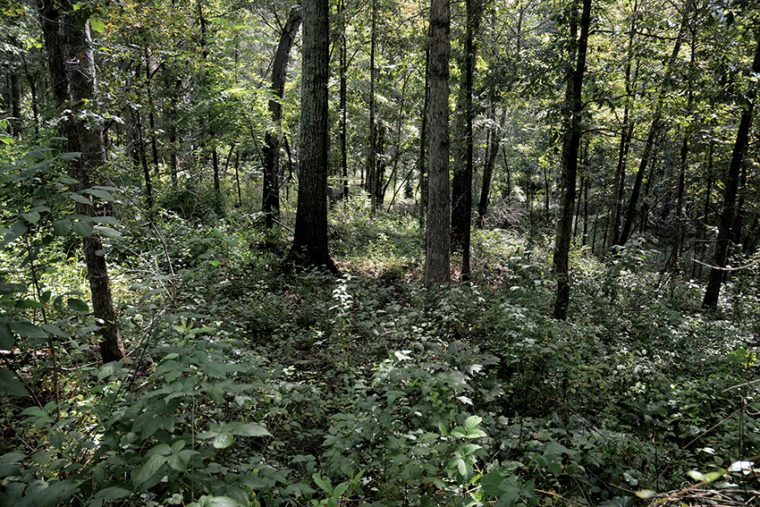If I ask you to imagine going outside today and creating some great deer habitat, what do you picture? Did you think of something you could add, like seeds or trees you can plant? Let’s be honest, adding things is what most of us think of first. But I’ve come to realize that great deer habitat can also be made by subtracting.
Dr. Craig Harper of the University of Tennessee calls it Forest Stand Improvement (FSI) – removing surplus or non-native trees and shrubs to restore some percentage of the sunlight that fuels an explosion of ground-level forage and cover within a forest, like you see in the photo above, taken in one of Craig’s study areas. Once you learn to identify a few common shrubs and trees that have little wildlife or commercial value, including many that are harmful invasives, you start to see abundant opportunities to create great deer habitat by removing them. Given extra space to grow, the beneficial trees you select to leave will now produce more acorns, nuts, or berries.
The question then becomes how to subtract, and you have lots of options. Working in Georgia under Craig’s guidance, I’ve learned an approach that I’ve found to be extremely useful, effective and easy – girdling or cutting down trees with a chainsaw and spraying the girdle or stump with herbicides that kill it.
Any species of desirable tree can be overabundant. White oaks are valuable and produce high-quality, attractive acorns, but you can have too many of them.
Yes, you can inject herbicides into cuts made with a hatchet or machete and kill trees just as dead – known as the “hack-and-squirt” method. Craig’s girdle-and-spray chainsaw method gives you much more flexibility as you work your way through a stand. With a light chainsaw in your hands, you can:
- Girdle a large tree for herbicide injection and kill it standing.
- Cut down small trees and shrubs and treat the stumps with herbicide.
- Cut down small trees and shrubs with forage value and leave them alive to create “mineral stumps.”
- Hinge-cut a small tree to create instant structure.
Applying FSI to any given stand, you will likely encounter the need for all of these options. But only one of them is on the menu when you’re holding a machete. So, here’s a basic guide to FSI with a chainsaw and squirt bottle, including some of the most important lessons I’ve learned from experience. Part 1 covers how to determine your area of work and then how to sort the trees you’ll remove from the trees you’ll leave. Part 2 gets into the finer points of the technique, including herbicide guidance.
Step One, Shut Off Your Saw
Before you read further, know that all of the following assumes you have basic tree-identification skills. Do not begin FSI unless you can identify the most common native mast-producing trees, valuable timber trees, and non-native invasive trees where you hunt – even in winter by bark alone. Buy a good field guide, download an app, or go for a hike with a friend or local forester who can instruct you. You don’t have to know every tree. Even if you only recognize the single most common species in your woods that is a candidate for removal, then you can get to work on that one. But do not kill any tree you cannot identify.
Strategic Patch Selection
Step two is deciding where to start your FSI effort. The vast majority of eastern forests could stand to be improved for deer by adding skylights, and the same is probably true of most of the forested cover where you hunt. Time simply works against you here: Unmanaged forests quickly become shady and unproductive for deer. You’ll be biting off too much at once if you dive in and try to apply FSI to every acre of forest you hunt. Be strategic. Select small stands or patches to tackle each year.
Mark Turner, a graduate student at Auburn University who studied FSI under the direction of Dr. Will Gulsby and Craig, had a great suggestion for me on how to choose your first area: Start with patches that are already surrounded by firebreaks, or those where firebreaks could be easily installed, so you can follow up with prescribed fire easily. Fire will be important for maintaining forage and cover. If you don’t burn at intervals, those patches will eventually revert back to overcrowded, shaded stands of trees.

Select small, manageable patches of forest to start your FSI work. The best patches are those where firebreaks already exist or could be easily installed, since prescribed fire will be important to maintaining quality cover in the future.
Set a patch size that’s reasonable for you given your time, equipment and amount of help available. Work on multiple patches annually if you have the time so you can create a patchwork of different stages of plant regeneration. Locate your patches where you most need cover and forage while taking into consideration your own ease of access for follow-up treatments, deer-stand locations and more.
The Cut-or-Leave Decision
Your patch is selected, and you’re ready to work. Now comes the task of studying tree species, size and proximity and deciding what to do with each of them. Let’s look at some of the choices you can make.
Trees to Kill Standing
These will include trees that are too large to conveniently and safely drop, whether they are invasive tree species you want dead so they stop reproducing or native trees that are prolific reproducers and therefore overabundant in the patch. It’s certainly possible to take the time to make a felling-cut and safely direct large trees to the ground, but then they become obstacles in your work area. Why take the time and risk to drop large trees when you can girdle-and-spray in less than 30 seconds?
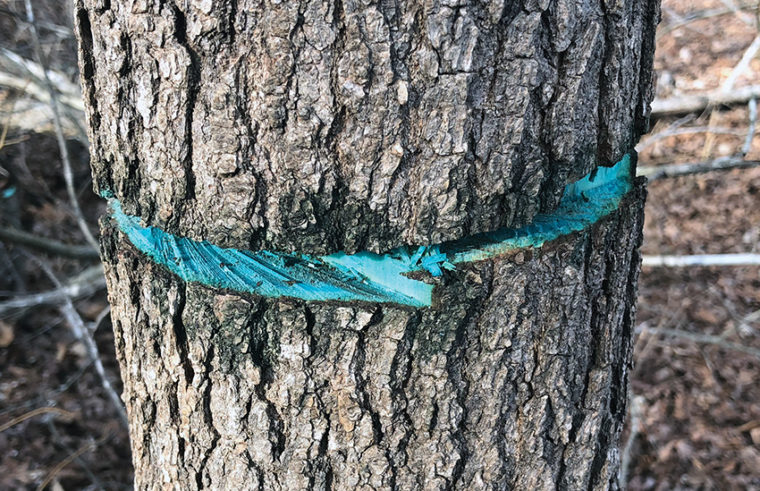
It takes less than a minute to girdle and spray a standing tree, killing it effectively. This is quicker and safer than trying to drop the entire tree, and there are fewer obstacles in your work area.
Trees to Fell and Kill
This includes trees that are too small to be girdled easily but can be dropped with a single saw cut. Often, young stands of abundant saplings of about 1 to 4 inches in diameter present this opportunity to simply cut and stump-spray quickly without girdling. When I’m doing this, I simply cut the tree off at waist-height, because it’s easier and safer than squatting or bending to cut it off near the ground. It’s also easy to spray the stump at this height. The resulting stobs may look unsightly to you, but they’ll rot and fall or disappear in new grass and forb growth soon enough.
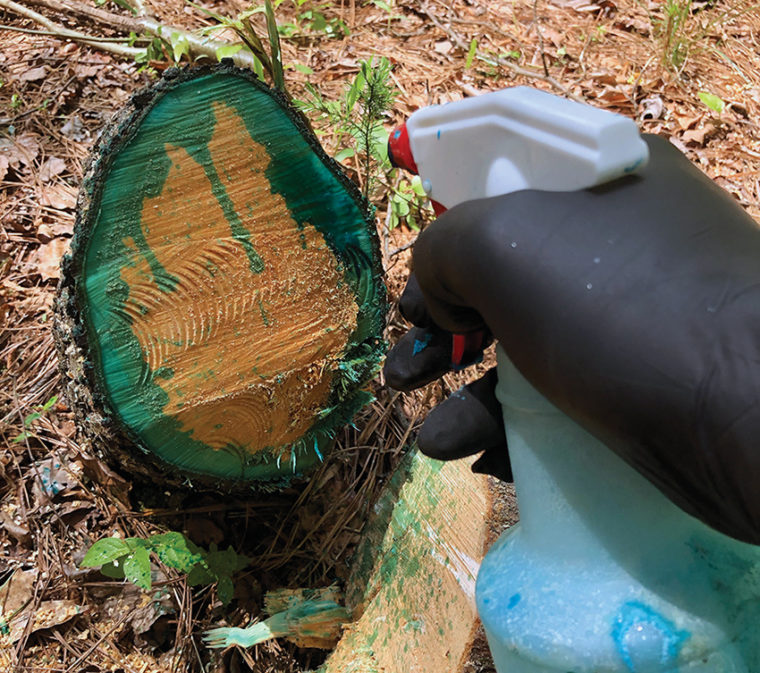
Invasive tree species, like this Callery (Bradford) pear, should be killed by stump spraying if they are small enough to fell. Without herbicide treatment, this stump would sprout and regrow.
In Georgia, we’ve done a lot of work daylighting the shoulders of woods roads and food plot openings. We girdle-and-sprayed a lot of trees in these zones, and guess what happened? After dying, they eventually started falling across the roads or into the openings. This required multiple additional rounds of effort with a chainsaw to clean them out of the roads or plots as they fell intermittently during wind storms. So, my advice now is, on the edges of roads or food plots, go ahead and use directional felling cuts to drop these trees away from the openings or roads, then spray the stumps. It takes more time to kill the tree, but it’s a one-and-done job.
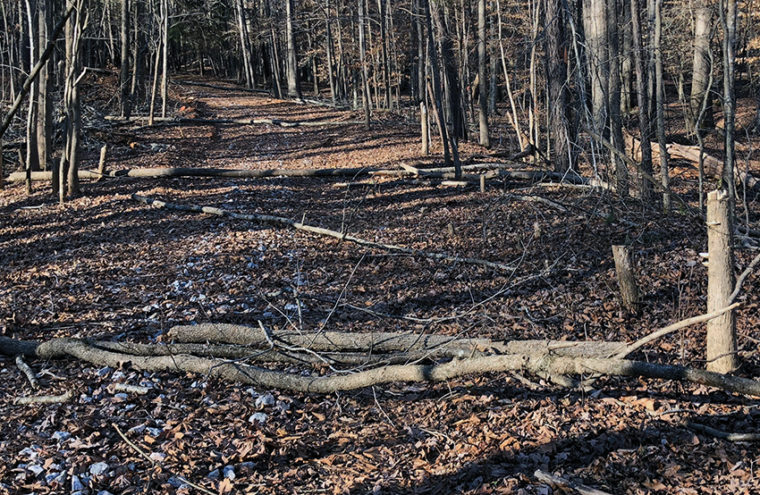
Trees along roads and food plot edges should be dropped with a directional felling cut away from the opening. Otherwise, if you kill them standing, they’ll eventually fall in the road and create more work.
Trees to Fell and Leave Alive
I mentioned “mineral stumps” earlier. This is a term coined by Dr. Marcus Lashley when he was at Mississippi State University for a tree stump that produces sprouts that will be high-preference forage for deer. Marcus found these sprouts are especially high in nutrients and minerals because they are fed by the root system of an entire tree, far better and more attractive forage than the buds and leaves on the branches of the same tree if you hinge-cut it.
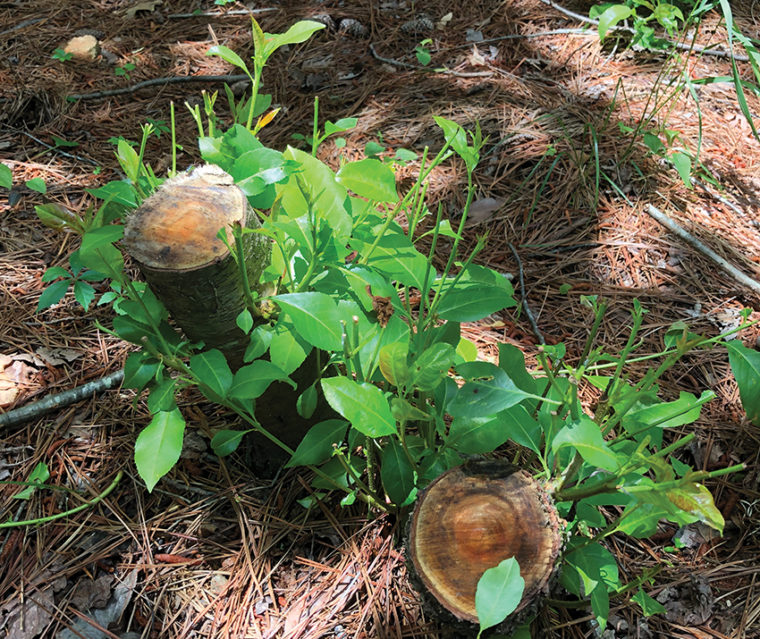
Some native species of trees make good “mineral stumps” because deer prefer the stump shoots as forage, and the stumps should not be treated with herbicide. Deer are heavily browsing these black cherry stumps.
Here in Georgia, red maple, blackgum, black cherry, winged elm and tulip poplar are among species that make the most desirable mineral stumps. When we encounter these in small sizes that are easy and safe to cut down, we don’t spray the stumps with herbicide. We leave the tree alive. Deer will kill it eventually by browsing the sprouts.
I don’t try to make mineral stumps out of trees that are too big to quickly and safely drop. I girdle and spray those. The more trees you choose to drop, the more clutter there is in your patch, and the more difficult and risky it is for you to work.
Trees That Present Several Options
Any species of desirable tree can be overabundant. White oaks are valuable and produce high-quality, attractive acorns, but you can have too many of them. Removing surplus white oaks and selecting down to one individual in a given space will allow that tree to outproduce the crowd you eliminated. Research by Craig Harper and his students has shown that giving an oak tree room to grow is the most effective way to increase acorn production.
Beech is another example. Beech trees produce a lot of shade for their typical shape and size, so they are often great candidates for removal. However, they also sporadically produce beech nuts, and you may want to have a few around for that reason. Again, remove the surplus, restore sunlight, and leave a select few individuals to be more productive. The same may go for other native species that have some wildlife benefits you want to maintain. Hickory trees produce nuts that squirrels eat, but that doesn’t mean every hickory is sacred. Mulberries are a fantastic wildlife tree for the fruit, but the stump sprouts are also supremely attractive to deer. I put them to both uses as the situation allows.
By the way, Dr. Craig Harper has just released a new publication on Forest Stand Improvement, including a fantastic reference guide to tree species and their value as deer forage, mast production or hinge-cut suitability. Order the 36-page guide here for $10.
This gives you a good idea of the general approach to applying FSI in your selected patch of woods with a light chainsaw. Next, I’ll cover the girdling technique, the recommended herbicide blend, the two-person team FSI method, and other important pointers.
